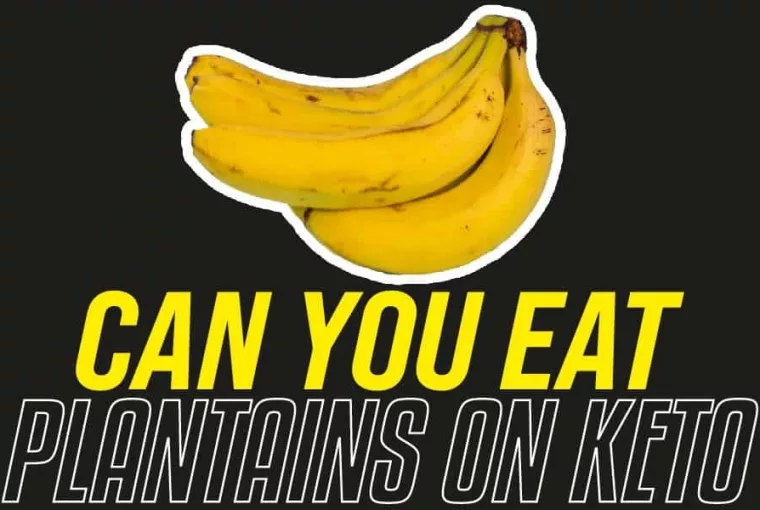Keto, also commonly referred to as a ketogenic diet, is a unique diet aimed at helping with weight loss.
It consists of eating high in fat and low in carbohydrates. While on a diet, your body will achieve a state of ketosis.
Ketosis is a state in which the ketone bodies in the tissue increase. Ketone bodies usually are produced by the liver in the absence of carbohydrates. They assist in the production of energy for your muscles.
Keto has a lot of health benefits, including weight loss, improved cardiovascular health, minimizing risk factors for certain types of cancer, etc.
Do you want to get started on a keto diet? Click here for an informative and simplified guide that will undoubtedly give you bang for your buck!
While a ketogenic diet emphasizes reducing your carbohydrate intake, Can You Eat Plantains on Keto?
Plantain is NOT a part of a ketogenic diet and should be avoided. Plantain is high in carbohydrates. It has a 31.824% concentration of carbs, which is simply too high for a ketogenic diet. Regular bananas should also be avoided while on a ketogenic diet.
What Consists Of Keto Diet?
We know that a ketogenic diet consists of high-fat and low-carb food. It aids in archiving ketosis and increases the process of weight loss.
The Keto diet can be divided into four main sub-categories. These categories are determined by the ratio of fat, protein, and carbohydrates per serving.
These categories are:
1. Standard Ketogenic Diet
It is the most common keto diet. It consists of fat to protein to carbohydrate diet in the ratio of 7:2:1.
For every 10 grams of carbohydrate intake, you should consume 20 grams of protein and 70 grams of fat. The diet is intended to stimulate the ketosis process fast.
When on a Standard Ketogenic Diet, you should take no more than 25 grams of carbohydrates per day.
2. Targeted Ketogenic Diet
The Targeted Keto Diet is quite similar to the Standard Ketogenic Diet. While on the TKD, you can eat carbohydrates 45 minutes before exercising.
Note that Targeted Ketogenic Diet is only suitable for people doing intensive exercise. Avoid TDK for cardio, as it will interfere with ketosis and ruin your diet.
3. Cyclical Ketogenic Diet
Cyclical Ketogenic Diet is a regiment that combines the STK with days of high carbohydrate intake. It is recommended for people who do intense manual work or athletes.
The CKT is intended to break the ketosis state and initiate glycogenesis. During the high carb intake days, the body can utilize carbs during respiration and provide energy for intense physical activities.
4. High Protein Ketogenic Diet
A high protein ketogenic diet utilizes the ratio of 6:3:1 for fat, protein, and carbohydrates. For every 10 grams of carbohydrates, you should eat 30 grams of protein and 60 grams of fat. Note that if your protein intake is too high, it might interfere with ketosis.
The Ketosis Process
Ketosis occurs as a natural response to carbohydrate deficiency. It is the process by which a metabolic function occurs in the liver, causing elevated ketone bodies in the blood. The process can be induced through low-carb intake or fasting.
Inducing ketosis by minimizing carbohydrate intake is known as nutritional ketosis. Any involuntary increase in the ketone levels to an unrestricted level is known as ketoacidosis. It is a symptom of insulin deficiency in diabetes patients.
For nutritional ketosis, the ketone levels in the blood and urine remain below 3mN. If the body remains in a state of prolonged ketosis, the body will experience vitamin deficiency.
Benefits Of A Ketogenic Diet
While taking a high-fat diet might seem counterintuitive, it has several health benefits if the body stays in ketosis.
A ketogenic diet serves many purposes, and it has been recommended as a solution to several health problems. Let us take a look at some of the benefits of a ketogenic diet:
1. Treatment of Epilepsy
Ketogenic dieting has been scientifically proven to minimize epileptic seizures in patients under 18. Studies have shown that an essential keto diet can reduce epileptic attacks in children by half.
A ketogenic diet works well when combined with epilepsy medication. A keto diet can help manage the condition.
2. Treating Cardiovascular Ailments
A keto diet can help manage risk factors likely to trigger heart disease. Note that the type of fat taken is essential. Healthy fats such as Omega 3 and unsaturated fats are preferable for a ketogenic diet.
3. Cancer Treatment
Ketosis is essential in depriving cancerous cells of glucose. The cellular metabolic processes slow down by minimizing the insulin supply to cancerous cells, inhibiting their accelerated growth.
Research is still being conducted on the validity of ketogenic dieting to slow the growth of cancerous cells.
4. Polycystic Ovary Syndrome Management
Ketogenic dieting can be used in Polycystic ovary syndrome management through managing the risk factors.
By controlling the levels of insulin released by the kidneys, dieting could mitigate the severity of Polycystic ovary syndrome.
5. Reducing the Risk of Developing Renal Problems
A study has shown that ketogenic dieting can potentially reduce renal diseases. Prolonged carbohydrate deprivation led to increased hydroxybutyric acid levels. It inhibits an aggressive response to glucose. Research on the subject is still being conducted.
What To Expect In The Initial Stages Of A Ketogenic Diet
As is with any diet, you will experience side effects with keto. These side effects may be mild or extreme depending on your body’s reaction to carbohydrate deprivation and high fat intake.
Some of the side effects are:
1. Nausea
Feeling nauseous is a reasonably common side effect of a ketogenic diet. Nausea is triggered by a high fat intake, which can be overwhelming for most folk. Eventually, the body should adjust to high fat intake.
If nausea persists, you should consider common anti-nausea medication. Ensure that you get a prescription from a professional.
2. Fatty Liver
A high-fat diet inevitably leads to a fatty liver. It is because of the increase in fat being deposited on the linings of the liver. Fatty liver disease causes inflammation and discomfort to the patient.
A fatty liver will leave you vulnerable to contracting steatohepatitis if not treated. An adverse form of the disease ultimately causes non-alcoholic cirrhosis. A common symptom of fatty liver disease is fatigue.
3. Low Energy and Fatigue
Cutting back on carbohydrates will cause you to experience fatigue, even after performing non-energy-intensive tasks.
Carbohydrates are digested into glucose and oxidized during respiration to provide energy for the muscles. Decreasing the intake of carbs with, therefore, cause you to tire quickly.
Metabolizing protein into energy is a slow process, but it will eventually provide you with basal energy levels to get you through the day.
4. Premenopausal Cardiovascular Illness
Multiple scientific studies have suggested that a ketogenic diet has the potential to increase risk factors that cause the illness.
An influx of ketone deposits on the heart can lead to permanent scarification. The formation of scar tissues can be fatal and ultimately lead to heart failure. Atrial fibrillation is also likely to occur in women approaching menopause.
5. Low Blood Protein
Low blood protein or hypoproteinemia is a condition developed by 10% of keto diet users. Low blood protein causes skin degradation and inflammation of the liver if left untreated for long periods.
6. Hypoglycemia
If you are hypoglycemic and want to start a keto diet, you should consult your doctor. There is the possibility of developing chronic symptoms, and it is undesirable. It may also be ill-advised to induce ketosis when you are hypoglycemic.
7. Vitamin Deficiency
If you are on a keto diet, it is advisable to take vitamin supplements to reduce the severity of the deficiency. Fruits may remove the body from a state of ketosis.
They contain fructose, which is digested into glucose and galactose. High fructose levels will interfere with your keto diet.
Consult your doctor for recommended supplements if you are on a keto diet.
8. Constipation
A keto diet is typically devoid of fiber. Most naturally occurring fibers are found in carbs. You may, therefore, experience constipation during the first few weeks of switching to a keto diet. If it happens, be sure to take plenty of water during the day.
Conclusion
A ketogenic diet is a high-fat, low-carb diet with numerous health benefits. It works by putting the body in a state of ketosis, i.e., increasing the number of ketone bodies in the tissue.
While plantain is usually a healthy food option, it simply does not form part of the keto diet. Its carbohydrate concentration is too high and should be avoided at all costs.




